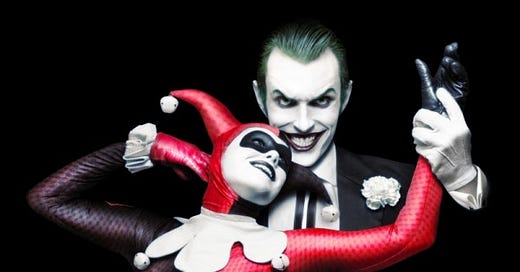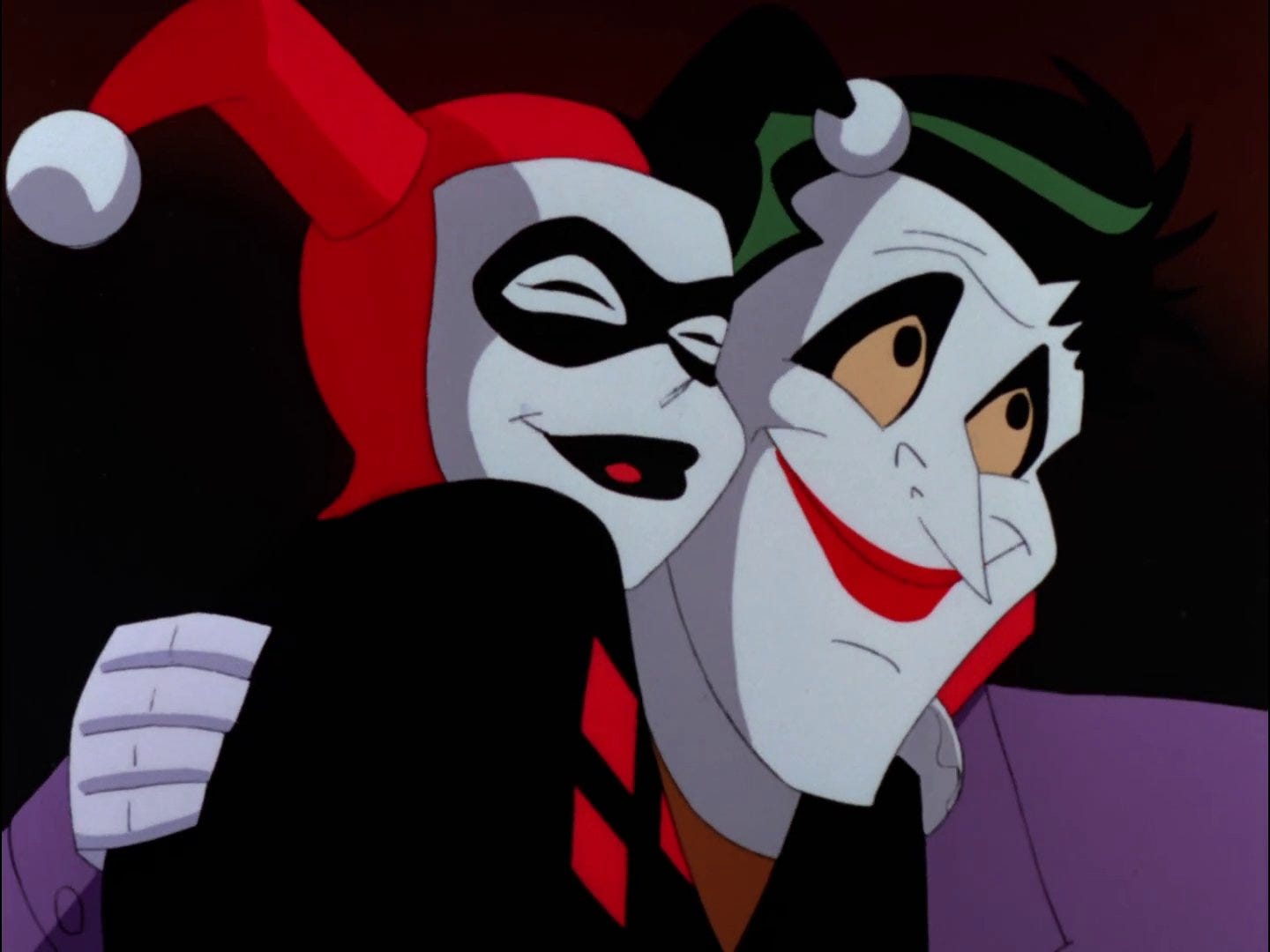If you're intimidated by the absurdly large amount of homework involved in catching up with the DC animated universe, don't worry about watching it all! Our last two installments explored the best episodes for Mr. Freeze and Ra's al Ghul. This installment tackles what has become one of DC's most popular characters, Harley Quinn.
Originally created on a whim because the plot demanded a female henchman, Harley Quinn's first appearance is in Batman: The Animated Series, "Joker's Favor" (Episode 22). The episode implies Harley is only working for the Joker as an alternative to going to beauty school. In "The Laughing Fish" (Episode 34), Joker attempts to trademark a fish poisoned by his laugh-inducing toxin, which he force feeds to Harley despite her protests that seafood makes her nauseated. Neither of these installments are particularly important to the character's development, however. Harley Quinn picked up steam later.
In "Harley and Ivy" (Episode 56), we establish that Joker has been sleeping with his hench girl, and their relationship already has a pattern of dysfunction: Joker puts too much on Harley, Harley is blamed and dumped when things go wrong, they miss one another and share a moment of reconciling sweetness, and they live together again in temporary peace. Joker puts Harley down even when she does good work, possibly because her success threatens his own fragile pride. Harley sticks up for herself half-heartedly, possibly because she believes Joker's criticism.
"Maybe I should just let you run the gang!" Joker taunts. "Maybe you're a better crook than the rest of us put together!"
"Maybe?" Harley replies. Joker throws her out in a rage. Harley defiantly resolves to show him — show them all! — by making a standalone villain of herself, adding with a wimper, "I miss him already."
Rather than actually finding her identity as an individual, Harley Quinn falls in with another villain named Poison Ivy, who typically hates all human beings but finds Harley endearing if somewhat irritating. As with Harley’s last relationship, this relationship features a power imbalance. Ivy mockingly and condescendingly tells Harley to handle her feelings for Joker by denying them, and Ivy makes Harley eat vegetarian. (As an aside, it doesn't make any sense for a villain obsessed with "plant genocide" to eat plants; ecoterrorist or not, Poison Ivy ought to be on a carnivore — even cannibal — diet.)
Joker rightly recognizes Ivy as a threat to his power. He also takes the news of Harley's successful crime spree extremely personally. Harley has no idea how angry he is when she secretly calls him, hanging up as Ivy walks through the door. He traces the call. Harley is both aroused and insulted when Joker says he's come to "collect what's [his]." Ivy fights him and drags Harley away. When Batman's work is finished and the dust is settled, Joker sits in Arkham Asylum swearing that his next gang will have no women.
"I think we can work it out," sighs Harley.
Ivy throws mud in her face.
In "Harlequinade" (Episode 72), Batman and Robin team up with Harley Quinn, temporarily releasing her from Arkham so that she can help stop Joker from dropping an atomic bomb on Gotham City. Harley is an amusing foil for the stoic Batman. The adventure also includes a dark humor musical number about domestic violence. Despite Joker's horrifying plans, Harley remains delighted and impressed with his work until Batman points out Joker had no qualms about dropping the bomb on her as well. Joker isn't even concerned about himself: "That bomb's going off even if I go with it!" Harley turns vengeful but — after nearly murdering Joker — melts at the first compliment he sends her.
Arkham Asylum discharges Harley as cured and legally sane in "Harley's Holiday" (Episode 81). She excitedly buys a dress but leaves before the clerk can remove the security tag, which sets off the alarm and draws the attention of a security guard. Harley assumes she’s being profiled. Her first day on the outside proves frustrating, but not so much that she is actually driven back to a life of crime. Rather, she turns her problems into an excuse to do what she already wanted to do: be Harley Quinn. After a day and a night of intense hijinks, Harley finds herself back at Arkham, but Batman also delivers the dress she's paid for. "I had a bad day too, once," he tells her.
Fun fact: When a 12-year-old I was watching saw Harley plant a grateful kiss on the only somewhat unwilling Batman, the boy immediately walked away from the TV and told me, “I don’t like Batman anymore.”
The most important Harley Quinn story is arguably in The New Batman Adventures, Episode 21, "Mad Love." After being humiliated and thrown out by Joker again, Harley reflects on her ruinous life and the source of all her ills: Batman, naturally! We flash back to Harley's first day as a practicing psychiatrist, Dr. Harleen Quinzel. (The comic book adaptation states that Harley slept her way to a degree.) Her patient, the Joker, immediately targets her and points out that her name sounds like “Harlequin.”
The reference works on two levels. First, Harlequin is a light-hearted clown servant from 16th century theater who, a romantic hero, often frustrates his master’s plans; in later English plays, Harlequin was a foil for the character Clown. Second, the Harlequin Romance novels are infamous for their melodrama and sensuality.
Though Harleen is, at first, bemused by these wordplays based on her name, Joker wins her over. He paints himself as a former victim of child abuse and current victim of Batman. Soon the two have reversed roles. While Dr. Quinn expresses her insecurity and helplessness, Joker reassures her.
His escape from Arkham fills her with anxiety for his well-being. His return to Arkham after he’s been physically brutalized by Batman causes her to have a breakdown. She assums the identity "Harley Quinn" and breaks him out. This would, in her mind, be "Happily Ever After," but Joker can't stop obsessing over Batman.
What makes this episode so important is not Harley's origin story but what happens afterward. Joker can't settle on how he wants to kill Batman because the death of Batman must be an unforgettable masterpiece. (In truth, Joker wouldn’t know who he was without Batman.) Rightly identifying Batman as competition for Joker's attention (and twisted affection), Harley sets out to eliminate the dark knight by improving on one of Joker's scrapped plans. Batman cannot be lowered into a tank of hungry piranhas because even his toxin cannot make piranhas smile. Harley's solution is to lower Batman in upside-down so that they will appear to be smiles from Batman's perspective.
Joker is insulted that the "joke" has to be explained but, worse than that, enraged by the realization that Harley is funnier than he is. He throws her through a window, leaving her for dead in the alley below.
Joker has put Harley in the same brutalized condition that Batman renders Joker. She is returned to Arkham in much the same way. This affords her a sudden clarity. Internally, she recognizes Joker for the monster he is and swears to herself that it's over. The moment Joker sends a rose, however, she is lovestruck again.
Creator Paul Dini calls Joker "the least human of Batman's enemies," and Harley Quinn was a way of humanizing him without delving into the workings of Joker's festering mind. This is vastly preferable to a Joker origin story, which would ruin Joker’s mystique, and it grounds his psychopathy in a real-world crime story that anyone can understand. Harley Quinn also works well as a standalone character: entertaining in that she is kooky, unpredictable and often the butt of the joke, and sympathetic in that she is compassionate, gets drawn into abusive relationships, and works against her own best interests.
Throughout my years of working with children from broken homes or women who found themselves homeless and pregnant by men who can't support them, I have found the classic characterization of Harley Quinn to be incredibly useful for illustration the cycle of abuse theory. As observed by psychologist Lenore Walker, the same events tend to repeat in abusive relationships. The four stages are as follows:
Tension
Incident
Reconciliation/Honeymoon
Calm
While this was mainly used to describe violence between intimate partners, it has since been adapted to all forms of abuse, whether physical, sexual, emotional, or other.
The Joker is a narcissist obsessed with his own weakness and the appearance of greatness. Like any narcissist, he views relationships as transactions. It is all about manipulating the behavior he wants rather than using honest communication or genuine emotional connection. Harley, meanwhile, believes herself to be more helpless than she really is. She also believes Joker needs her. Whereas Poison Ivy controls Harley by trying to cut off Harley’s other relationships, Joker controls Harley by making her think he will die without her.
Audiences feel for Harley Quinn because they want to see this cycle of abuse end, either by breaking up Joker and Harley once and for all or (in the case of those with more questionable taste and idealistic views on human nature) reconciling them forever.
Movies, comics, and other shows break the classic Joker/Harley formula this way. They no longer lay out the patterns of abusive relationships in a way that is easily recognized and reflected upon, instead opting for a more heavy-handed approach of portraying a feminist ideal. Harley Quinn is never the butt of the joke anymore. She must be a real doctor, intelligent, self-aware and strong. She must want to kill the Joker. If she isn't someone's idea of a role model, she's a "bad female character." While Harley Quinn is probably more popular than ever, no story seems to carry the same profound weight as Mad Love. Must we fix what isn't broken?
This is not the only way we felt the need to improve upon Harley Quinn. The shows did little to nothing to establish a lesbian relationship between Harley and Ivy, but Bruce Timm's art certainly fetishized them this way, and other iterations of the characters have canonized their relationship. I can't say I find it a particularly wholesome rebound story that Harley has gone from one mass murderer to another simply because this mass murderer is female. That would all be well and good if we were at least meant to see some irony. Instead, this is supposed to be positive representation of lesbians in media. When the condescension and control comes from another woman, is it any less abusive? If Poison Ivy murders people to save the trees, is it less murderous? Are the people who would answer “yes” to these questions really the ones we want producing our media?
In my opinion, the best of Harley Quinn begins and ends with the above episodes. What do you think?









Harley Quinn is among the most compelling characters in Batman's rogues gallery. Her dysfunctional relationship reveals a lot about deep human psychology. But as you said, Harley's also an amusing foil to the stoic Batman. Couldn't have put it better myself! Awesome article, from one Batman fan to another!
I think we should go back to OG Harley, because the original character made by Dini and Co. is brilliant. When I revisited the Animated Series a few years back, I was impressed with how well her character was, and her interaction with Bats in the dress episode. Her response, “Nice guys like you shouldn’t have bad days”, and the way she says it is another little detail which builds upon the tragedy and psychology of her character.